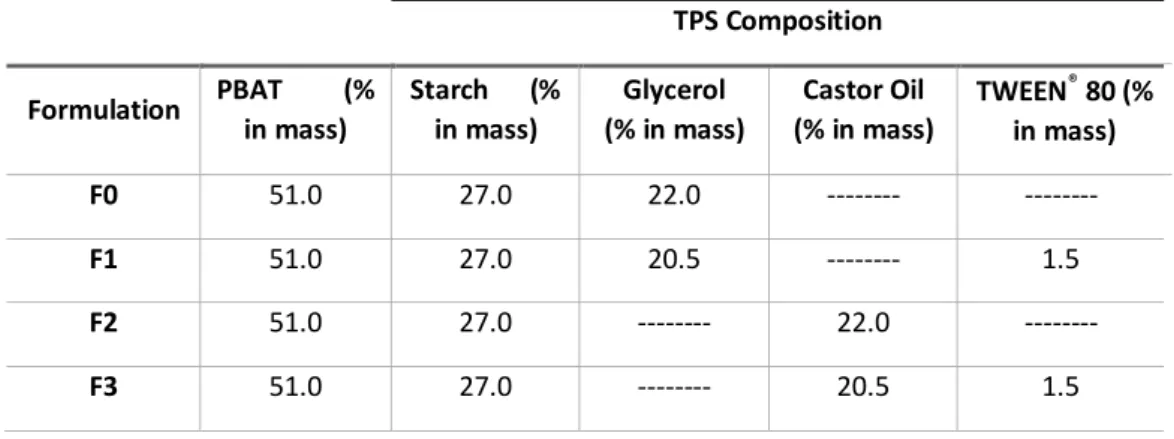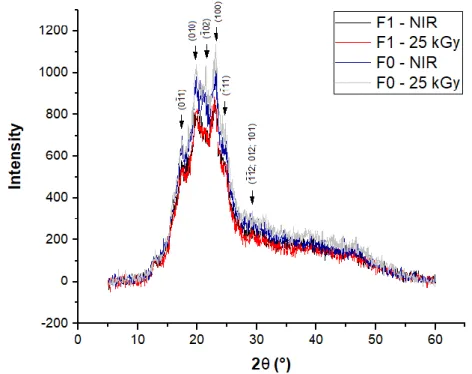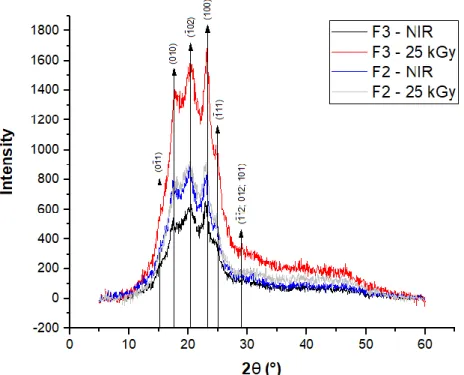Characterization using X-ray diffraction and study of the crystallinity of the
thermoplastic starch/poly(butylene adipate-co-terephthalate) blends irradiated
by gamma rays
Caracterização por DRX e estudo de cristalinidade de blendas de amido
termoplástico/poli (butileno adipato-co-tereftalato) irradiadas por raios gama
DOI:10.34117/bjdv6n3-005
Recebimento dos originais: 30/12/2019 Aceitação para publicação: 28/02/2020
Dione Pereira de Castro
Mestre em Ciências pela Universidade de São Paulo Instituto de Pesquisas Energéticas e Nucleares, IPEN-CNEN/SP
Av. Professor Lineu Prestes, 2242, Cidade Universitária, São Paulo - SP, Brasil pereira@usp.br
Rafael Henrique Lazzari Garcia
Doutor em Ciências pela Universidade de São Paulo Instituto de Pesquisas Energéticas e Nucleares, IPEN-CNEN/SP
Av. Professor Lineu Prestes, 2242, Cidade Universitária, São Paulo - SP, Brasil rlgarcia@ipen.br
Leonardo Gondim de Andrade e Silva Doutor em Ciências pela Universidade de São Paulo Instituto de Pesquisas Energéticas e Nucleares, IPEN-CNEN/SP
Av. Professor Lineu Prestes, 2242, Cidade Universitária, São Paulo - SP, Brasil lgasilva@ipen.br
ABSTRACT
The aim of this study was to analyze the changes in the structure and crystallinity of non-irradiated and irradiated thermoplastic starch blends (TPS)/poly (butylene adipate-co-terephthalate) - PBAT and also to evaluate the behavior of castor oil replacing glycerol. In this work, the characterization was performed by using X-ray diffraction (XRD), in which the crystallinity index (IC) of non-irradiated and non-irradiated blends of TPS/PBAT was calculated, through the software Bruker DIFFRAC.EVA® v4.22. For the plastification of the TPS, glycerol, castor oil and TWEEN® 80 were used to verify their compatibility and establish a comparison among the blends. The samples were prepared by extrusion and irradiated at 25 kGy with gamma rays with a 60Co source. However, the crystallinity indexes of the blends were altered according to the plasticizer used and the use of TWEEN® 80. Thus, it was concluded that replacing glycerol with castor oil is feasible in TPS/PBAT blends.
Keywords: Crystallinity, XRD, Blends, TPS, PBAT. RESUMO
O objetivo deste estudo foi verificar as alterações na estrutura e cristalinidade de blendas de amido termoplástico (TPS)/poli (butileno adipato-co-tereftalato) – PBAT não irradiadas e irradiadas e também avaliar o comportamento do óleo de mamona em substituição do glicerol. Neste trabalho, foi realizada a caracterização pela técnica de difração de raios X (DRX), na qual foi calculado o índice de cristalinidade (IC) das blendas não irradiadas e irradiadas, por meio do software Bruker
DIFFRAC.EVA® v4.22. Para a plastificação do TPS, glicerol, óleo de mamona e TWEEN® 80 foram utilizados para verificar a compatibilidade e comparar as misturas entre si. As amostras foram preparadas por extrusão e irradiadas a 25 kGy com raios gama de uma fonte de 60Co. Entretanto, os índices de cristalinidade das blendas foram alterados de acordo com o plastificante utilizado e o uso do TWEEN® 80. Concluiu-se que a substituição do glicerol pelo óleo de mamona é viável nas blendas de TPS/PBAT.
Palavras-chave: Cristalinidade, DRX, Blendas, TPS, PBAT.
1 INTRODUCTION
Biodegradable products based on polysaccharides are widely available in nature and constitute an important class of biopolymers. Among them, starch is a low-cost and renewable carbohydrate polymer, available from great variety of crops. It has various applications in packages, biomedical devices, and industrial composting (Moustafa; Guizani; Dufresne, 2017; Pan et al., 2016). Among them, some aliphatic and aliphatic aromatic biodegradable polyesters, such as poly (lactic acid) - PLA and poly (butylene adipate-co-terephthalate) – PBAT are widely used in packaging applications due to both their favorable mechanical properties and final improvement of the properties of blends with other materials (Moustafa; Guizani; Dufresne, 2017). TPS/PBAT blends also have low cost and good chemical properties, which are suitable for several applications.
Radiation processing is considered one of the most promising techniques for modifying biodegradable polymers, as it offers several advantages over other modification methods, being an environmentally friendly, controllable process with no additives, temperature and low energy consumption. Thus, this technique has been widely used for modifying several biodegradable polymers (Akhavan; Khoylou; Ataeivarjovi, 2017; Hwang et al., 2010).
This study is mainly focused on XRD curve behavior and crystallinity index of TPS/PBAT blends.
2 MATERIALS AND METHODS
Amidex® 3001 starch from Ingredion, biodegradable PBAT copolyester, Ecoflex® F Blend C 1200 from BASF SE, Sigma-Aldrich® Glycerol G9012, castor oil from A. Azevedo Ind., and
surfactant TWEEN® 80 P1754 from Sigma-Aldrich® were used in the experiments. The formulations
Table 1. Formulations of TPS/PBAT blends and other components TPS Composition Formulation PBAT (% in mass) Starch (% in mass) Glycerol (% in mass) Castor Oil (% in mass) TWEEN® 80 (% in mass) F0 51.0 27.0 22.0 --- --- F1 51.0 27.0 20.5 --- 1.5 F2 51.0 27.0 --- 22.0 --- F3 51.0 27.0 --- 20.5 1.5
In addition to corn starch, plasticizers were used in the preparation of the blends: glycerol, castor oil and TWEEN® 80, according to the formulations shown in Table 1. They were weighed together with the PBAT pellets in triplicate and solubilized partially with the aid of a mechanical stirrer at 400 rpm for 2 minutes until obtaining consistency and homogeneity followed by a manual mixing due to the plasticity and swelling of the formulations during the incorporation of plasticizers into both the starch and PBAT.
Samples were extruded in the corroting screw extruder of AX Plásticos Máquinas Técnicas Ltda. The material was cooled by forced ventilation and water passage. Subsequently, samples were cut into pellets and separated into individual packages for the irradiation process at 25 kGy in the
60Co irradiator, Gammacell 200, at a dose rate of 0.662 kGy/h at room temperature in the presence of
air. The later characterization of the blends was performed by using X-ray diffraction (XRD), carried out on the equipment Multiflex model from Rigaku, using monochromatic radiation CuKα (λ = 1,541 Å) radiation under a voltage of 40 kV and 20 mA current, diffraction angle between 5-60°, and scanning speed of 4 s. and 0.06° step.
The CI in the blends was calculated according to Equation 1 (Pan et al., 2016), using the software Bruker DIFFRAC.EVA® v4.22:
CI % = (CA/TA)*100 (1)
3 RESULTS AND DISCUSSION 3.1. X-RAY DIFFRACTION (XRD)
The angles of PBAT and the respective crystallographic planes obtained from the literature (Pan et al., 2016) are shown in Table 2.
Table 2. PBAT angles and diffractions plane reference.
PBAT - Diffractions plane reference
2ϴ 16.00° 17.22° 20.12° 23.00° 24.72° 28.52° dhkl
The X-ray diffraction curves of F0 blends (NIR - 25 kGy) with glycerol in its composition (Figure 1) showed similarities with the other blends.
Figure 1. XRD curves: non-irradiated (NIR) and irradiated blends at 25 kGy composed by glycerol and TWEEN® 80
In Figure 1, the XRD diffractograms of F1 blends (NIR - 25 kGy), composed of glycerol and TWEEN® 80 are shown. No noticeable differences among the diffractograms could be observed. The
from the PBAT and starch at 20 kGy reported in the literature (Atrous et al., 2015; Kumar et al., 2017; Moustafa; Guizani; Dufresne, 2017; Pan et al., 2016).
The diffraction peaks coincided with those of pure PBAT and irradiated starch, and are in agreement with the results from the literature (Atrous et al., 2015; Gani et al., 2012; Kumar et al., 2017; Moustafa; Guizani; Dufresne, 2017; Pan et al., 2016), which reported 5 crystalline peaks and their transitions.
The X-ray diffractograms of blends F2 and F3, composed of Castor oil (OM)/TWEEN® 80 presented similarities, as shown in Figure 2.
Figure 2. XRD curves: non irradiated (NIR) and irradiated blends at 25 kGy composed by castor oil and TWEEN® 80
The peaks defined at 17°, 20° and 23° are in agreement with the literature (Atrous et al., 2015; Gani et al., 2012; Kumar et al., 2017; Moustafa; Guizani; Dufresne, 2017; Pan et al., 2016). Concerning the irradiated F3 blends, the crystalline peaks had greater amplitude than the non-irradiated F3 blends (NIR) composed of OM and TWEEN® 80.
3.2. CRYSTALLINITY INDEX (CI)
The calculated values of Crystallinity Index (CI) from the diffractograms seen in Figure 3 are shown in Table 3.
For the calculation of the crystalline area (CA), the graph area underwent correction of the baseline (background - BG), disregarding the remaining peaks of the diffractograms.
Figure 3. XRD curves: non irradiated (NIR) and irradiated blends at 25 kGy for Crystallinity Index (CI) calculation
Table 3. Crystallinity Index (CI) values calculated from the XRD data
Blends XRD Curves (Total area) Crystallinity Area (CA) Crystallinity Index (CI) % Variation in Crystallinity (NIR/25 kGy) % F0 - NIR 11.847 4.262 36.0 0.1 F0 - 25 kGy 13.007 4.668 35.9 F1 - NIR 10.430 3.546 34.0 3.5 F1 - 25 kGy 9.825 3.687 37.5 F2 - NIR 9.156 4.016 43.9 1.5 F2 - 25 kGy 10.265 4.657 45.4 F3 - NIR 6.762 2.844 42.1 3.7 F3 - 25 kGy 18.316 8.394 45.8
According to the data presented in Table 3, the F0 blends had no meaningful changes in the percentage of crystallinity (0.1%) after irradiation. The F1 blends had change in crystallinity in both the non-irradiated and irradiated samples (3.5%) and with TWEEN® 80. Sample F0 without surfactant presented a crystallinity difference of 3.4% (3.5% - 0.1%). That was the largest difference among NIR samples, thus demonstrating the chemical interaction of TWEEN® 80 in the blends analyzed.
In the irradiated F1 blend, a higher percentage of crystallinity was obtained in comparison to the F0 - NIR sample, showing the interaction of TWEEN® 80 in the blend analyzed.
The CI of the blends may increase through the effects of radiation, possibly due to preferential degradation of the amorphous regions of amylopectin (Atrous et al., 2015; Kumar et al., 2017).
The chemical interaction of oleic acid, which is also present in the composition of TWEEN® 80 as plasticizer, favored a better thermal resistance and stability for the starch relative to the glycerol; moreover, the plasticization process occurred more efficiently. Those results are in agreement with the studies conducted by Schlemmer, Sales and Resck, (2010).
The F2 blends showed higher average values of crystallinity in relation to samples F0 and F1 and in relation to their irradiated and non-irradiated compositions (1.5%), both obtaining the highest individual crystallinity value calculated among all formulations. The chemical interaction between the components of the blend and OM by esterification was observed and studied by other researchers (Moustafa; Guizani; Dufresne, 2017; Sathiskumar and Madras, 2011).
The F3 blends with OM and F3 with TWEEN® 80 had significant changes in CI (3.7%) after
irradiation. Among all analyzed samples, the F3 blend with TWEEN® 80 had the highest individual
crystallinity index value (45.8%).
4 CONCLUSIONS
It was observed that the samples did not show significant changes caused by the gamma radiation in their X-ray diffraction patterns. Regarding the crystallinity index (CI), the results demonstrated that there was a change in crystallinity according to both the type of plasticizer used and the use of TWEEN® 80. A difference in crystallinity was noticed between samples F1 – NIR and F1 – 25 kGy (3.5%) with the incorporation of TWEEN® 80. The F2-F3 blends obtained higher CI’s and crystallinity increased after irradiation, demonstrating chemical interaction among components and the possible radiation induced crystallization process with OM/TWEEN® 80 and starch/PBAT
after the plasticization and reactive extrusion process. It can also be concluded that the replacement of glycerol with castor oil is viable in TPS/PBAT mixtures.
ACKNOWLEDGEMENTS
The authors acknowledge CAPES and FAPESP for the financial support.
REFERENCES
Akhavan, A.; Khoylou, F.; Ataeivarjovi, E. Preparation and characterization of gamma irradiated Starch/PVA/ZnO nanocomposite films. Radiation Physics and Chemistry, v. 138, p. 49-53, 2017.
Atrous, H.; Benbettaieb, N.; Hosni, F.; Danthine, S.; Blecker, C.; Attia, H.; Ghorbel, D. Effect of gamma-radiation on free radicals formation, structural changes and functional properties of wheat starch. International Journal of Biological Macromolecules, v. 80, p. 64-76, 2015.
Gani, A.; Bashir, M.; Wani, S. M.; Masoodi, F. M. Modification of bean starch by gamma-irradiation: Effect on functional and morphological properties. Lwt-Food Science and Technology, v. 49, n. 1, p. 162-169, 2012.
Hwang, I. T.; Chan-Hee, J.; In-Choi, K.; Jae-Hak, C.; Young-Chang, N. Electron beam-induced crosslinking of poly(butylene adipate-co-terephthalate). Nuclear Instruments & Methods in Physics Research Section B-Beam Interactions with Materials and Atoms, v. 268, n. 21, p. 3386-3389, 2010.
Kumar, P.; Prakash, K. S.; Jan, K.; Swer, T. L.; Jan, S.; Verma, R.; Deppika, K.; Dar, M. Z.; Verma, K.; Bashir, K. Effects of gamma irradiation on starch granule structure and physicochemical properties of brown rice starch. Journal of Cereal Science, v. 77, p. 194-200, 2017.
Moustafa, H.; Guizani, C.; Dufresne, A. Sustainable biodegradable coffee grounds filler and its effect on the hydrophobicity, mechanical and thermal properties of biodegradable PBAT composites. Journal of Applied Polymer Science, v. 134, n. 8, p. 11, 2017.
Pan, H. W.; Ju, D. D.; Zhao, Y.; Wang, Z.; Yang, H. L.; Zhang, H. L.; Dong, L. S. Mechanical Properties, Hydrophobic Properties and Thermal Stability of the Biodegradable Poly(butylene adipate-co-terephthalate)/Maleated Thermoplastic Starch Blown Films. Fibers and Polymers, v. 17, n. 10, p. 1540-1549, 2016.
Sathiskumar, P. S.; Madras, G. Synthesis, characterization, degradation of biodegradable castor oil based polyesters. Polymer Degradation and Stability, v. 96, n. 9, p. 1695-1704, 2011.
Schlemmer D.; Sales M. J. A.; Resck I. S. Preparação, caracterização e degradação de blendas PS/TPS usando glicerol e óleo de buriti como plastificantes. Polímeros: Ciência e Tecnologia, v. 20, n. 1, p. 6-13, 2010.



